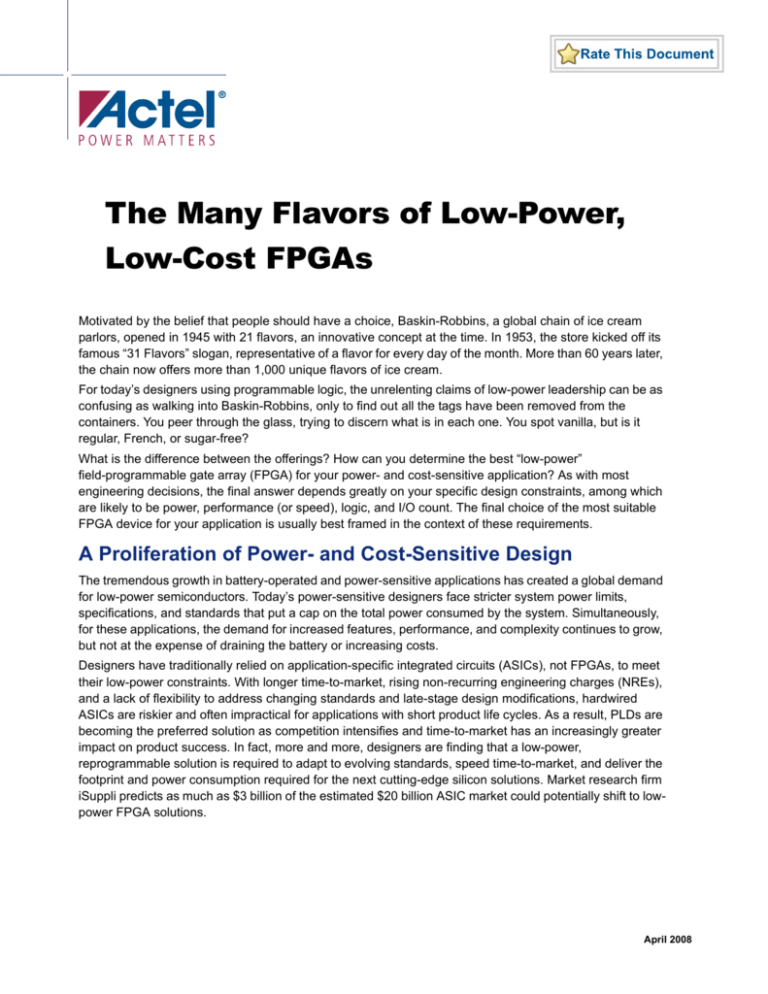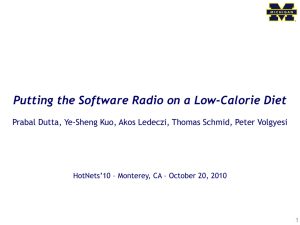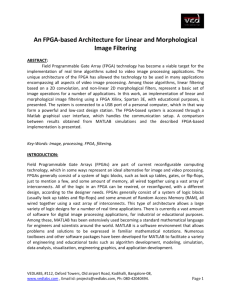
The Many Flavors of Low-Power,
Low-Cost FPGAs
Motivated by the belief that people should have a choice, Baskin-Robbins, a global chain of ice cream
parlors, opened in 1945 with 21 flavors, an innovative concept at the time. In 1953, the store kicked off its
famous “31 Flavors” slogan, representative of a flavor for every day of the month. More than 60 years later,
the chain now offers more than 1,000 unique flavors of ice cream.
For today’s designers using programmable logic, the unrelenting claims of low-power leadership can be as
confusing as walking into Baskin-Robbins, only to find out all the tags have been removed from the
containers. You peer through the glass, trying to discern what is in each one. You spot vanilla, but is it
regular, French, or sugar-free?
What is the difference between the offerings? How can you determine the best “low-power”
field-programmable gate array (FPGA) for your power- and cost-sensitive application? As with most
engineering decisions, the final answer depends greatly on your specific design constraints, among which
are likely to be power, performance (or speed), logic, and I/O count. The final choice of the most suitable
FPGA device for your application is usually best framed in the context of these requirements.
A Proliferation of Power- and Cost-Sensitive Design
The tremendous growth in battery-operated and power-sensitive applications has created a global demand
for low-power semiconductors. Today’s power-sensitive designers face stricter system power limits,
specifications, and standards that put a cap on the total power consumed by the system. Simultaneously,
for these applications, the demand for increased features, performance, and complexity continues to grow,
but not at the expense of draining the battery or increasing costs.
Designers have traditionally relied on application-specific integrated circuits (ASICs), not FPGAs, to meet
their low-power constraints. With longer time-to-market, rising non-recurring engineering charges (NREs),
and a lack of flexibility to address changing standards and late-stage design modifications, hardwired
ASICs are riskier and often impractical for applications with short product life cycles. As a result, PLDs are
becoming the preferred solution as competition intensifies and time-to-market has an increasingly greater
impact on product success. In fact, more and more, designers are finding that a low-power,
reprogrammable solution is required to adapt to evolving standards, speed time-to-market, and deliver the
footprint and power consumption required for the next cutting-edge silicon solutions. Market research firm
iSuppli predicts as much as $3 billion of the estimated $20 billion ASIC market could potentially shift to lowpower FPGA solutions.
April 2008
The Many Flavors of “Low-Power” FPGAs
Certainly not all programmable logic is well-suited to address low-power needs. In fact, some of today’s
“low-power” FPGAs draw upwards of 30 mA, which is often an order of magnitude or two higher than
typical power-sensitive, battery-operated applications can tolerate. At start-up, SRAM-based devices
experience well-documented inrush and boot-up configuration power spikes during system initialization
that can cause excess battery drain. Alternately, single-chip, flash-based devices do not require an
external configuration device (i.e., boot PROM or microcontroller) to support device programming at every
power-up cycle, and the live-at-power-up feature eliminates the need for an external device to assist in
system power-up. Removing the additional parts required by SRAM-based FPGAs not only reduces board
space and system power consumption, but also increases reliability, simplifies inventory management, and
lowers total system costs by as much as 70 percent compared with similar SRAM-based FPGA solutions.
Once the FPGA is on and configured, power consumption takes two basic forms—static and dynamic (also
called active). Static power consumption is the current drawn by your FPGA when it is powered up,
configured, and doing nothing; dynamic power is consumed when devices are actively working. Until
recently, dynamic power was the dominant source of power consumption. Once helping to manage the
dynamic power problem, device supply voltages (VCC) had scaled downward with process shrinks and
subsequent lower system voltages, but the days of continued scaling are gone. Compounding the issue
further, each process node shrink means additional static power consumption for transistor-heavy SRAMbased FPGAs. This is due to worsening problems such as quantum tunneling and sub-threshold leakage,
which create real challenges for devices targeted to power-conscious applications. And, with leakage
worsening, static power has begun to dominate the power consumption equation as the biggest concern
(Figure 1).
Figure 1: Static Power Significant at 90 nm
2
The Many Flavors of Low-Power, Low-Cost FPGAs
Figure 1 illustrates the increasing contribution of static power at shrinking process nodes.
To address some of these power concerns, several suppliers of SRAM-based FPGAs claim to offer “singlechip, flash-based” solutions. These “hybrid” solutions are merely combinations of flash memory
components with the underlying SRAM FPGA technology—either integrated with the FPGA die into a
single package or, alternatively, stacked or placed side-by-side. Unfortunately, the FPGA array is still
volatile and is subject to the power drawbacks associated with these types of devices. With these
solutions, the embedded flash memory blocks control only the initial configuration of the devices during
power-up. True nonvolatile FPGAs are those that contain a nonvolatile FPGA array, enabling significantly
reduced power consumption, improving response times, and delivering unparalleled reliability and
uncompromising security.
Both the silicon-in-package (SIP) and the multi-chip package (MCP) hybrid approaches overcome some of
the limitations of traditional SRAM-based solutions by providing a smaller footprint, a minor reduction in
power consumption, and small advances in power-up time and security. But these are only incremental
improvements over their pure SRAM-based peers. In some cases, these devices have been proven to
consume 1,000 times more static power than true flash-based FPGAs.
Because true nonvolatile flash-based FPGAs do not use millions of power-hungry SRAM configuration bit
cells, they have significantly lower static power than SRAM-based solutions, making them ideal for powersensitive applications. In fact, the many flavors of flash-based, low-cost FPGAs include devices that have
been optimized for power, speed, and I/O, some of the fundamental design requirements for power- and
cost-sensitive design.
Figure 2 highlights the flavors of flash-based, low-power FPGA families from Actel Corporation.
Speed
Power and
Speed
Power and
I/O
Power
Figure 2: Flavors of FPGAs
The Many Flavors of Low-Power, Low-Cost FPGAs
3
Optimized for Power
The industry’s lowest power programmable solutions at 5 µW, the Actel IGLOO® family offers between 10
times and 1,700 times less static power, setting a new bar for low power consumption. This significantly
lower power consumption can translate into weeks and months of standby battery life.
Figure 3 illustrates the tremendous static power advantage IGLOO has over competitive FPGA devices.
FPGA Static Power
70,000
57,930
60,000
Power (µW)
50,000
40,000
35,210
30,000
20,000
10,000
0
34
Actel
Competitor A
Competitor B
Figure 3: FPGA Static Power
The IGLOO family supports up to 250 MHz operation and offers 1.2 and 1.5 V operation, densities up to
3 million system gates, and enhanced features such as PLLs, RAM, and user nonvolatile memory.
Additional advantages of the flash-based IGLOO devices include flexible power-saving modes with rapid
recovery to operation, low dynamic power consumption, and clock management. Available in a 4millimeter (mm) package with a 0.4-mm ball pitch, the smallest package for any programmable logic device
on the market, IGLOO FPGAs are particularly attractive for applications where the absolute lowest power
and smallest size are critically important.
Today’s power-sensitive designer attempts to achieve the lowest power possible and to accommodate long
system idle times by allowing the system to enter and exit low-power modes quickly. To address this, the
Actel IGLOO family employs Flash*Freeze technology to enable power consumption as low as 5 µW while
maintaining FPGA content. Further, the Flash*Freeze pin enables designers to quickly and easily enter or
exit the special low-power mode within 1 µs. Further, while in Flash*Freeze mode, designers need not
power off voltage to the device or stop clocks or I/Os. Additionally, for low-power applications that require
32-bit processing, designers can use the ARM® Cortex™-M1 processor without license fee or royalties in
M1-enabled IGLOO devices.
The portable market, in particular, has seen tremendous need for storage, LCDs, and human interface
control due to the increasing popularity of personal media players, MP3 devices, PDAs, smart phones,
navigation devices, and digital cameras. As a result, Actel offers comprehensive IGLOO-based portable
storage and LCD control application solutions, such as development boards, reference designs and
intellectual property (IP) cores, to enable rapid design of their portable and power-sensitive applications.
4
The Many Flavors of Low-Power, Low-Cost FPGAs
Optimized for Power and I/O
Flash-based, 5 µW Actel IGLOO PLUS FPGAs have been optimized for I/O-intensive applications,
particularly those employing I/O-intensive memory bus manipulation, general-purpose I/O expansion,
sequencing, interface translation, storage, and human interface touchscreen and keypad technology.
Offering the industry’s best power-, area-, logic-, and feature-per-I/O ratios in a programmable device for
any given package size, an IGLOO PLUS device delivers 6 times better static power consumption, a 50
percent reduction in dynamic power consumption, a 200 percent improvement in I/O density, and as much
as 2.7 times the logic density compared with competitive programmable logic solutions in similar
packages. For example, a competitive SRAM-based programmable device in an 8 mm x 8 mm chip-scale
package offers 25 k equivalent system gates, 78 I/Os, and 25 mW typical static power versus the 60 k
system gates, 157 I/Os, and 10 µW of an AGLP060 IGLOO PLUS FPGA in the same package.
Actel IGLOO PLUS solutions also offer up to 16 times better power per I/O. Assuming a design requires
100 I/Os, the 120-I/O AGLP030 IGLOO PLUS device consumes 5 µW versus the roughly 60 µW of the
nearest competitive solution.
Figure 4 highlights competitive static power per I/O profiles across 30 k and 60 k density programmable
logic devices.
60 k System Gates
0.40
0.6
0.35
Power (µW) per I/O
Power (µW) per I/O
30 k System Gates
0.7
0.5
0.4
0.3
0.2
0.30
0.25
0.20
0.15
0.10
0.1
0.05
0
0
Competitor A
Competitor B
IGLOO PLUS
Competitor A
Competitor B
IGLOO PLUS
Figure 4: Competitive Static Power per I/O
In addition to up to 64 percent more I/Os per device than the company’s award-winning IGLOO family, the
IGLOO PLUS family also features four I/O banks for independent level shifting. Enabling the device to
better support varying voltage levels, this is key for bridging between application processors and
application-specific standard products (ASSPs), where differing I/O standards and voltages may be
utilized. IGLOO PLUS devices support cost- and area-effective level shifting between 1.2, 1.5, 1.8, 2.5,
and 3.3 V I/O standards and interface translation.
Additionally, IGLOO PLUS devices support independent Schmitt trigger inputs and hot-swapping. The
Schmitt trigger input delivers greater noise immunity in the circuit, enabling designers to safely identify an
input signal that rises slowly, such as a keyboard or human touchpad. The hot-swap capability offers
additional flexibility, as designers can now support direct system connection while powering up. This is
beneficial for applications such as portable media players and games, where solid state mass storage
modules and human interface controllers are often connected to and disconnected from the system in real
time.
The IGLOO PLUS family also supports Flash*Freeze bus hold, allowing users to hold the I/O states “on”
while the device is in Flash*Freeze mode. In a digital picture frame, for example, the IGLOO PLUS device
The Many Flavors of Low-Power, Low-Cost FPGAs
5
can be placed in Flash*Freeze mode to save power and will continue displaying a picture on screen. When
the picture needs to be changed, the IGLOO PLUS device can resume operation in a microsecond, having
saved hundreds of microwatts of power while in the I/O hold state. This same capability is critical in smart
phone, wireless audio, and video applications.
Balancing Power and Speed
For designers of high-performance, power-conscious systems, Actel’s ProASIC®3L family of FPGAs
combines 40 percent lower dynamic power and 90 percent lower static power than its previous-generation
ProASIC3 FPGAs, with up to 350 MHz operation. As a result, designers in high-performance market
segments, such as industrial, medical, and scientific, now have access to flexible, feature-rich solutions
that offer speed, low power, and low cost.
Dynamic power is critical in applications where clocks are constantly switching and providing input to an
FPGA, such as high-speed data pipelines for portable video and medical appliances. Like the company’s
award-winning 5 µW IGLOO FPGA family, ProASIC3L devices support a 1.2 V core and I/O voltage and
Actel’s innovative Flash*Freeze technology. Flash*Freeze enables designers to quickly switch the device
from dynamic operation to static without switching off clocks or power supplies. In a typical high-speed
design using comparable one-million gate FPGAs, SRAM-based competitive solutions consume 60
percent higher dynamic power and 100 times more static power than ProASIC3L devices, which consume
just 100 mA of dynamic power and 1 mW of static power.
Figure 5 compares power and performance at one million system gates across competitive “low-power”
FPGA solutions.
Power vs. Frequency at 1 M Gates
600
P roAS IC 3L
S R AM C om petitor
Hybrid S R AM C om petitor
500
Power (mW)
400
300
200
100
0
0
50
100
150
200
250
Frequency (MHz)
Figure 5: Power vs. Frequency at 1 Million Gates
The ProASIC3L family also supports the free implementation of the FPGA-optimized 32-bit ARM
Cortex-M1 processor, allowing system designers to select the Actel flash-based FPGA solution that best
meets their speed and power design requirements, regardless of application or volume.
6
The Many Flavors of Low-Power, Low-Cost FPGAs
Optimized for Speed
Actel’s low-power 1.5 V ProASIC3 FPGAs are optimized for performance. Featuring 350 MHz operation,
the one-million-gate ProASIC3 A3P1000 FPGA, for example, delivers standby current consumption of only
8 mA under typical conditions, nearly an order of magnitude lower than competing SRAM-based devices.
Further, with pricing as low as $0.99, designers in high-performance market segments, such as industrial,
medical, and scientific, now have access to flexible, feature-rich solutions that offer speed, low power, and
low cost.
Low-power applications that require 32-bit processing can use the ARM Cortex-M1 processor without
license fee or royalties in M1-enabled ProASIC3 devices, providing the benefits of programmability and
time-to-market at an ASIC-level unit cost.
Conclusion
For today’s designers using programmable logic, determining the best device depends greatly on power,
performance, logic, and I/O count design constraints. Like Baskin-Robbins, Actel believes designers
should have a choice regarding the best low-power FPGA for their power- and cost-sensitive applications.
For this reason, the company has built an attractive portfolio of the industry’s most compelling low-power,
low-cost FPGAs—a flavor for every palate.
The Many Flavors of Low-Power, Low-Cost FPGAs
7
For more information, visit our website at www.actel.com
w w w. a c t e l . c o m
Actel Corporation
Actel Europe Ltd.
Actel Japan
Actel Hong Kong
2061 Stierlin Court
Mountain View, CA
94043-4655
USA
Phone 650.318.4200
Fax 650.318.4600
River Court, Meadows Business Park
Station Approach, Blackwatery
Camberley Surrey GU17 9AB
United Kingdom
Phone +44 (0) 1276 609 300
Fax +44 (0) 1276 607 540
EXOS Ebisu Building 4F
1-24-14 Ebisu Shibuya-ku
Tokyo 150 Japan
Phone +81.03.3445.7671
Fax +81.03.3445.7668
Room 2107, China Resources Building
26 Harbour Road
Wanchai, Hong Kong
Phone +852 2185 6460
Fax +852 2185 6488
http://jp.actel.com
www.actel.com.cn
© 2008 Actel Corporation. All rights reserved. Actel and the Actel logo are trademarks of Actel Corporation. All other brand or product names
are the property of their respective owners.
55900082-0/4.08









